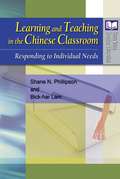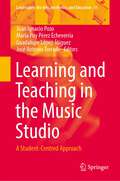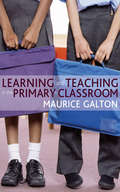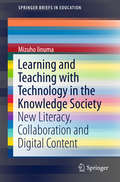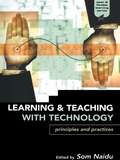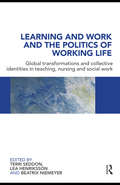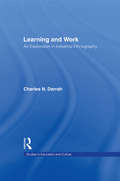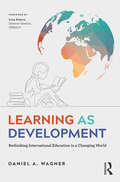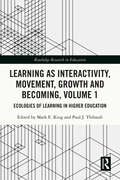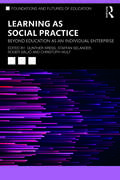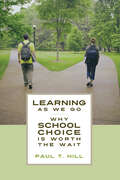- Table View
- List View
Learning and Teaching in Secondary Schools
by Viv EllisThis popular text for secondary teacher trainees covers all the key issues for learning and teaching in secondary schools and is a core text for all those working towards QTS. Focusing on a range of important topics, the text provides an essential summary of educational research and includes both reflective and school-based practical tasks. Throughout, case studies make essential links between theory and practice and the text focuses on what trainees need to know. This fourth edition includes new chapters on Masters level study for PGCE and pastoral care, citizenship and PSHE.
Learning and Teaching in Secondary Schools (Achieving QTS Series)
by Viv EllisLinked to the new Teachers' Standards, this is an essential text for all secondary trainees and PGCE students, training at an ITT institution or in a school. The text covers all fundamental issues for learning and teaching in secondary schools. It guides trainee teachers through the professional attributes, skills and knowledge they need, focusing on a range of key topics and summarising important educational research. It examines the curriculum, planning, assessing and SEN and explores EAL, equality and diversity and pastoral care. A chapter is included to help support students in their Masters level work at PGCE and throughout, interactive activities make essential links between theory and practice. In all chapters, practical examples demonstrates how all aspects relate to the classroom. About the Achieving QTS Series All the books in this successful series support trainees through their initial teacher training and guide them in the acquisition of their subject knowledge, understanding and classroom practice. All new titles within the series are linked to the 2012 Teachers' Standards adn consider the impact of key government initiatives. Viv Ellis is Professor of Head of Education at Brunel University in London, UK, and a Visiting Professor at Bergen University College in Norway.
Learning and Teaching in the Chinese Classroom
by Shane N. PhillipsonA major concern of all education authorities around the world is the challenge that schools face in catering for learner diversity. That this concern is shared by authorities in East Asia, including the Education Bureau (EDB) of Hong Kong, is surprising given the high academic achievement of students from this part of the world. This book helps to meet this challenge for teachers in East Asia by focusing on specific research that helps explain the basis for diversity in the Chinese learner. Although there are many textbooks that cover the basic principles of educational psychology, few do not focus on the Chinese learner. This book makes the link between the broad field of educational psychology and how these theories contribute to our understanding of the Chinese learner. This book is unique in that it draws on recent research to illustrate the application of these theories, thereby helping teachers and students in teacher education progammes understand the variability in student achievement. Our book is based on the idea that the Chinese context is in many ways different to other cultural contexts, and that teachers can make a difference to the outcomes of student learning. We also draw on our many years of experience in educating future teachers where our students want us to focus on the Chinese classroom. Our student-teachers also want to be educated by professors who are themselves researchers. In drawing on research about the Chinese learner we also bring to our student-teachers the richness and value of educational research. We also encourage our student-teachers to think of themselves as "professional researchers" in terms of developing an understanding of the research literature and in finding solutions to their classroom problems.
Learning and Teaching in the Early Years
by Jane Page Collette TaylerLearning and Teaching in the Early Years provides a comprehensive, contemporary and practical introduction to early childhood teaching in Australia. A strong focus on the links between theory, policy and practice firmly aligns this text with the Early Years Learning Framework. Written for students of early childhood programs, this book covers learning and development, as well as professional practice in teaching children from birth to eight years. In recognition of the evolving role of educators, topic areas include learning, teaching, working with families, leading, advocating and researching. Each chapter contains learning objectives, key terms and reflection points. Detailed case studies document the intersection between research, policy and practice, enhancing pre-service and practicing educators' appreciation of how a policy-aligned approach reinforces learning and development in the early years. This text draws on the latest research to present children's learning as a dynamic and active process requiring specific, intentional teaching behaviours.
Learning and Teaching in the Junior School (Routledge Revivals)
by Nancy CattyOriginally published in 1941, this book deals with the application of educational theory to the teaching of children between the ages of seven and twelve in large classes, mainly in state primary schools. It suggests how education based on children’s activities and interests can be organized and carried out; hence such problems as the following are discussed: the value of creative work and various forms of activity; social training and individual auto-education; group and class activities; the acquisition of habits of study and necessary skills; the teacher as a trainer, advisor and instructor.
Learning and Teaching in the Music Studio: A Student-Centred Approach (Landscapes: the Arts, Aesthetics, and Education #31)
by Juan Ignacio Pozo María Puy Pérez Echeverría Guadalupe López-Íñiguez José Antonio TorradoThis book advocates for a radical change in music teaching and learning methods, allowing for a break from the traditional conservatory model still in use in many classrooms. The product of twenty years of interdisciplinary work by musicians, music teachers, and psychologists, the book proposes to place the focus of music education on the students themselves and on their mental and physical activity, with the aim of helping them to manage their own goals and emotions. This alternative is based on a new theoretical framework, as well as numerous real, concrete examples of how to put it into practice with students of different ages and in different environments. This book focuses primarily on teaching instrumental music, but its content will be useful for any teacher, student, musician, or researcher interested in improving music education in any environment, whether formal or informal, in which it takes placeChapters 3, 4, 6 and 18 are available open access under a Creative Commons Attribution 4.0 International License via link.springer.com.
Learning and Teaching in the Primary Classroom
by Maurice J GaltonProviding a framework for understanding the individual needs of pupils, this book describes how you can tailor your teaching methods to maximise learning. You will learn how to take account of your pupils′ knowledge, skills and attitudes when selecting and applying principles of instruction, in order to make learning in your classroom as successful as possible. Packed with informative case studies and classroom examples, this book explores how learning is conceptualised, direct instruction, interactive teaching, teaching as scaffolding, and how to overcome obstacles to learning. This is a must-read for all practitioners and students of primary education who wish to understand how to best apply theories of instruction, and provide effective, dynamic teaching.
Learning and Teaching with Interactive Whiteboards: Primary and Early Years (Achieving QTS Practical Handbooks Series)
by David Barber Linda Cooper Mr Graham MeesonInteractive Whiteboards (IWBs) are becoming increasingly common in schools and early years settings, and it is important for trainees to be equipped with the necessary skills and understanding to use them effectively to enhance learning. This book takes a thematic approach, examining all the key issues required to get the most out of this versatile learning technology. All chapters contain case studies from a range of subject areas and across the key stages, ensuring the text is rooted in the reality of the primary classroom and its curriculum.
Learning and Teaching with Maps
by Patrick WiegandA comprehensive and authoritative account of how primary school children and teachers can use maps to enhance learning and deepen understanding of this essential skill. It includes all aspects of map use, such as reading and interpreting maps and using maps to find the way, covering maps of all scales, including globes and atlases. The text is extensively illustrated with examples, including maps made by children themselves using conventional materials as well as computer software. A particular feature of the book is the integration of digital and conventional mapping, and Internet and CD-ROM cartography together with simple applications of Geographic Information Systems (GIS) appropriate to the needs of children right through primary and secondary education. This book will be of great use to all primary teachers and subject teachers in secondary school as well as non-specialist geography teachers, and will enable children to use all types of maps in new, compelling and thoughtful ways.
Learning and Teaching with Technology in the Knowledge Society
by Mizuho IinumaThis book discusses learning and teaching with modern technology in the new knowledge society. It focuses specifically on new literacy and technology in classroom environments. Based on a social-constructivist approach, this book covers a wide range of new technology use examples, such as participatory media, video recording systems and 3D computer graphics. A case study on a constructivist approach to teaching and learning, especially CSCL (computer supported collaborative learning), is discussed from a practical perspective for educators. It also includes specific in-class practices with detailed accounts of curricula featuring readily accessible yet new technology available for classroom use, such as Google Sketchup 3D computer models.
Learning and Teaching with Technology: Principles and Practices (Open and Flexible Learning Series)
by Som NaiduIncreased use of electronic libraries, multimedia courseware and computer-mediated communication is giving rise to an entirely new educational experience, prompting educators to assess the potential for improved and enriched learning and teaching models. This new book explores the creative opportunities offered by ICT, and provides an authoritative, rigorous survey of the ways in which ICT is currently transforming core teaching functions, including: *subject matter representation*activating learning and the engagement of students*supporting interaction and socialization*assessing learning outcomes*providing feedback to students. Written by leading experts in the field, this text draws on the experiences of practitioners at the forefront of ICT developments, making this essential reading for all educational professionals who recognize the new opportunities afforded by this changed environment. Suitable for those who are open and flexible learning specialists, educational technologists or educational developers in either a conventional or an e-learning environment.
Learning and Teaching: The Essential Guide for Higher Level Teaching Assistants
by Anne WatkinsonLearning and Teaching concentrates on the practical teaching skills that an HLTA needs to be able to use in the classroom. It offers guidance and support on fulfilling the standards and succeeding in the classroom role. This book includes: real-life case studies that put the theory behind the standards into a whole-school context practical activities that convey how the standards can be used in the classroom guidance on the school-based aspects of the training and assessment advice on the difference between the learning and teaching standards for newly qualified teachers and HLTAs. This book is complemented by a companion volume, Professional Values and Practice which underpins the philosophy, values and practice of support at this level.
Learning and Work and the Politics of Working Life: Global Transformations and Collective Identities in Teaching, Nursing and Social Work
by Terri Seddon Lea Henriksson Beatrix NiemeyerLarge scale changes in work and education are a key feature of contemporary global transformations, with a pervasive politics that affects people’s experiences of workplaces and learning spaces. This thought-provoking book uses empirical research to question prevailing debates surrounding compliance at work, education and lifelong learning, and emphasises the importance of debate and dissent within the current terms and conditions of work. Examining a number of types of work, including teaching, nursing and social work, through a transnational research space, the contributors investigate how disturbances in work both constrain and enable collective identities in practical politics. Structured around three main themes, the book covers: Disturbed work: with cases of occupational reform in nursing and vocational teaching in Finland and re-regulating work in Australia Disturbing work: examining contested occupational knowledge in German school to work transitions, paraprofessional healthwork in the UK, social work in Finland, and mobilising professional expertise in US Community College faculty and Australian adult literacy Transforming politics: negotiating an ageing workforce in Germany, young adults moving through identities and careers, building a politics of ‘we’ through a global book project An enlightening collection of international contributions, this book will appeal to all postgraduate students, researchers and policy makers, in education, work, and lifelong learning.
Learning and Work: An Exploration in Industrial Ethnography (Studies in Education and Culture #8)
by Charles N. DarrahFirst published in 1996. Routledge is an imprint of Taylor & Francis, an informa company.
Learning and development
by Rebecca Page-TickellTailored to the needs of HR and learning and development (L&D) practitioners, this book offers an overview of the field that is strongly aligned to organizational strategies and objectives. Using a combination of practical tools, assessments, scenarios and international case studies, this handbook builds readers' knowledge of the area -- from diagnosing L&D needs and types of intervention and development categories, to assessment and training evaluation. Page-Tickell provides the skills needed to implement a successful L&D strategy in any type of organization.
Learning and the Metaverse: What this Technology Means for L&D
by Donald ClarkWhat is the metaverse? Will it really happen? How will it affect learning and development (L&D)? Where do I start?Learning and the Metaverse explains where the Metaverse came from, what it is, where it is going, debunks the myths and demystifies the jargon. It shows how it can be used to improve training and learning activities. Written by a learning technology expert with more than 35 years' experience, this book explains what this shift from 2D to 3D learning involves and what it means for you as a learning professional. It analyses the evidence for effective learning in 3D and explains what works and what doesn't. There is also guidance on designing training that can be used in the Metaverse and why it's important to consider how people learn when doing this. This book includes discussion of the Metaverse and broader education as well as coverage of virtual reality (VR), augmented reality (AR), immersive technology and learning simulations. This guide contains everything learning professionals need to know about learning and the Metaverse.
Learning as Development: Rethinking International Education in a Changing World
by Daniel A. WagnerLearning is the foundation of the human experience. It begins at birth and never stops, a continuous and malleable link across life stages of human development. Disparities in learning access and outcomes around the world have deep consequences for income, social mobility, health, and well-being. For international development practitioners faced with today's unprecedented environmental and geopolitical pressures, learning should be viewed as a touchstone and target for those seeking to truly effect global change. This book traces the path of international development work—from its pre-colonial origins to the emergence of economics as the dominant discipline in the field—and lays out a new agenda for policymakers, researchers, and practitioners, from early education through adulthood. Learning as Development is an attempt to rethink international education in a changing world.
Learning as Interactivity, Movement, Growth and Becoming, Volume 1: Ecologies of Learning in Higher Education (Routledge Research in Education)
by Paul J. ThibaultThe two inter-linked volumes in this series are dedicated to the development of analysis and theorisation of learning and teaching in higher education. The two volumes focus on the multi-scalar ecological inter-connectedness of learners with teachers, with artefacts, with cultural patterns and resources, with places, with social activities and practices, with social institutions, with time and temporality, and with technologies. Learning reflects inter-individual dynamics that are shaped by biology and culture. Against prevailing orthodoxies that view learning in higher education in terms of "information transmission" and "content delivery," the contributors articulate leading developments in distributed cognition, distributed language, ecological psychology, enactivist and embodied-embedded cognitive science, interactivity, and multimodal event analysis. They also extend several earlier traditions such as American pragmatism, embodied curriculum theory, and Vygotsky's latter day anti-dualist Spinozan turn. Through detailed empirical analysis of in vivo episodes of learning using multimodal event analysis, cognitive event analysis, and cutting-edge theory, the authors show how and why learning is not adequately explainable as internal mental processes per se. Instead, sophisticated empirical analysis and innovative theory are put to work to reveal the emergence of learning in the interactivity of learners and teachers with the affordances of a distributed brain-body-environment learning system. Volume 1 is an edited collection of seven chapters written by internationally renowned researchers together with an Introduction and an Afterword written by King and Thibault. Volume 1 (and its successor Volume 2) will serve as valuable reading for educationalists and researchers in the cognitive, communication, learning, and language sciences who are looking for new multidimensional tools for thinking about, and new empirical tools for analysing, learning, and teaching as multi-scalar interactive processes in radical embodied ecologies of learning and teaching.
Learning as Social Practice: Beyond Education as an Individual Enterprise (Foundations and Futures of Education)
by Gunther KressThis book studies learning as a social enterprise, contextually situated, organized and assessed. It gives a broad theoretic grounding for an understanding of learning which goes beyond a common reductionist approach. The book discusses four related approaches to learning which share a social perspective: social semiotics and multimodality; a design-theoretic approach to learning; a socio-cultural perspective; and a perspective of mimetic learning. Contributing authors consider the theoretical question of how to understand educational systems, learning and social communication as historically situated practices. The chapters in this book analyze key working practices including: analyzing what learning, remembering and cognitive work is like in a practice involving different kinds of expertise; problem-solving and engaging through collaboration; learning and teaching in different formal, semi- and non-formal environments; a design-theoretic approach to learning; social semiotic perspectives on learning; the mimetic and ritual dimension of learning; how social learning can be organized to support students; how learning has been conceptualized in psychology and neighbouring research areas. This book will be of great interest to students and researchers interested in learning and meaning-making, multimodal representations and communication, designs for learning, education and teaching, and social achievement in different formal and non-formal contexts.
Learning as We Go: Why School Choice is Worth the Wait
by Paul T. HillPaul T. Hill examines the real-world factors that can complicate, delay, and in some instances interfere with the positive cause-and-effect relationships identified by the theories behind school choice. He explains why schools of choice haven't yet achieved a broader appeal and suggests more realistic expectations about timing and a more complete understanding of what must be done to make choice work.
Learning as a Creative and Developmental Process in Higher Education: A Therapeutic Arts Approach and Its Wider Application
by Clive Holmwood Judie TaylorMuch has been written about the importance of creativity in learning and education over the last few decades. This unique book extends beyond the usual focus on implementing creative methods in learning, teaching and assessing within higher education, to an examination of creativity as central to a learning process which is transformational for the student. More specifically, Learning as a Creative and Developmental Process in Higher Education examines the importance of a facilitative tutor-student relationship and environment which contextualise this creative process of teaching and learning. Bringing together unique teaching and learning approaches developed by experienced academics, this book discusses a number of complex issues, including approaches to an understanding of the student’s self-concept as learner; the nature of the curriculum; the potential of metaphor and creativity; and a multi-modal approach to learning and teaching. Contributions to the book also examine some of the challenges and tensions of such an approach within the context of arts-based subjects in higher education institutions. Using a unique and coherent thematic structure that is based upon the student journey as a transformational process, this book provides a new way of understanding the student journey through higher education. Including an examination of the parallels between educational and arts education and arts therapies disciplines, this book will be of interest to researchers, academics and postgraduate students involved in the arts and the arts therapies, as well as those studying creativity in teaching and learning in higher education. It should be of particular interest to those involved in the teaching and training of teachers and lecturers in higher education.
Learning as a Generative Activity
by Richard E. Mayer Logan FiorellaDuring the past twenty-five years, researchers have made impressive advances in pinpointing effective learning strategies (namely, activities the learner engages in during learning that are intended to improve learning). In Learning as a Generative Activity: Eight Learning Strategies that Promote Understanding, Logan Fiorella and Richard E. Mayer share eight evidence-based learning strategies that promote understanding: summarizing, mapping, drawing, imagining, self-testing, self-explaining, teaching, and enacting. Each chapter describes and exemplifies a learning strategy, examines the underlying cognitive theory, evaluates strategy effectiveness by analyzing the latest research, pinpoints boundary conditions, and explores practical implications and future directions. Each learning strategy targets generative learning, in which learners actively make sense out of the material so they can apply their learning to new situations. This concise, accessible introduction to learning strategies will benefit students, researchers, and practitioners in educational psychology, as well as general readers interested in the important twenty-first-century skill of regulating one's own learning.
Learning at Home Pre K-3: Homework Activities that Engage Children and Families
by Ann C. BarbourFamilies play a critical role in helping young children develop a solid academic foundation and love of learning. Numerous examples have proven time and again that children's learning behavior is strongest when reinforced with activities, social interactions, and play. In Learning at Home, PreK-3, Ann Barbour stresses the importance of getting parents involved with their children's education through engaging homework activities. Bursting with activities to foster learning on many levels, this book also offers ideas for teachers on how to include parents in their children's education. Discover hundreds of fun activities designed to:Relate learning directly to children's own experiencesInclude shared reading experiences, family projects, and gamesIntegrate developmental and content areas, including language and literacy, mathematics, science, and the creative artsPromote literacy learning in homes where English is not the primary languageAnd moreThis book gives teachers the tools to reach out to families and provides parents with the guidance to reinforce learning both in school and at home. Complete with tips on how to encourage parent involvement, data to support family commitment to the child's education, and activities that young students will enjoy doing at home with their families, Learning at Home is a fantastic resource to promote the joy of learning at home.
Learning at Home, PreK–3: Homework Activities That Engage Children and Families
by Ann C. BarbourCreate a strong home-school connection through family activities that extend learning! Packed with hundreds of engaging activities, this unique resource helps teachers plan developmentally appropriate, creative homework assignments that encourage positive learning experiences and reinforce home-school connections. Focusing on social interactions within the family, these fun, playful activities: <p><p> Relate directly to children’s own experiences <p> Employ concrete, easily accessible materials <p> Include shared reading experiences, family projects, and games <p> Integrate developmental and content areas, including language and literacy, mathematics, science, and the creative arts <p> Promote literacy learning in homes where English is not the primary language
Learning at Speed: How to Upskill and Reskill your Workforce at Pace to Drive Business Performance
by Nelson SivalingamThe world is changing fast, but are you? Do you know where the skills gaps are in your organization? Do you know how to fill these gaps? Most importantly, can you make the necessary changes quickly enough to succeed?Learning at Speed is a practical book which brings together the best from lean and agile methodologies to show how they can be applied to learning and development (L&D) to improve individual and organizational performance. This provides a people development framework which can be used to deconstruct a learning strategy and optimise each element for improved results. It shows how to identify learning barriers and possible solutions, leverage company data to understand learning needs and how to assess the most effective learning resources and delivery channels. Crucially, Learning at Speed shows how to track metrics that matter, get the most from your budget and how to build a business case to get stakeholder buy-in. Understanding how to continuously upskill and reskill a workforce at speed will ensure that organizations can stay ahead of the competition. Supported by templates, worksheets, case studies, examples and practical advice, this book is the practical guide that shows learning and development (L&D) professionals how to achieve this.


